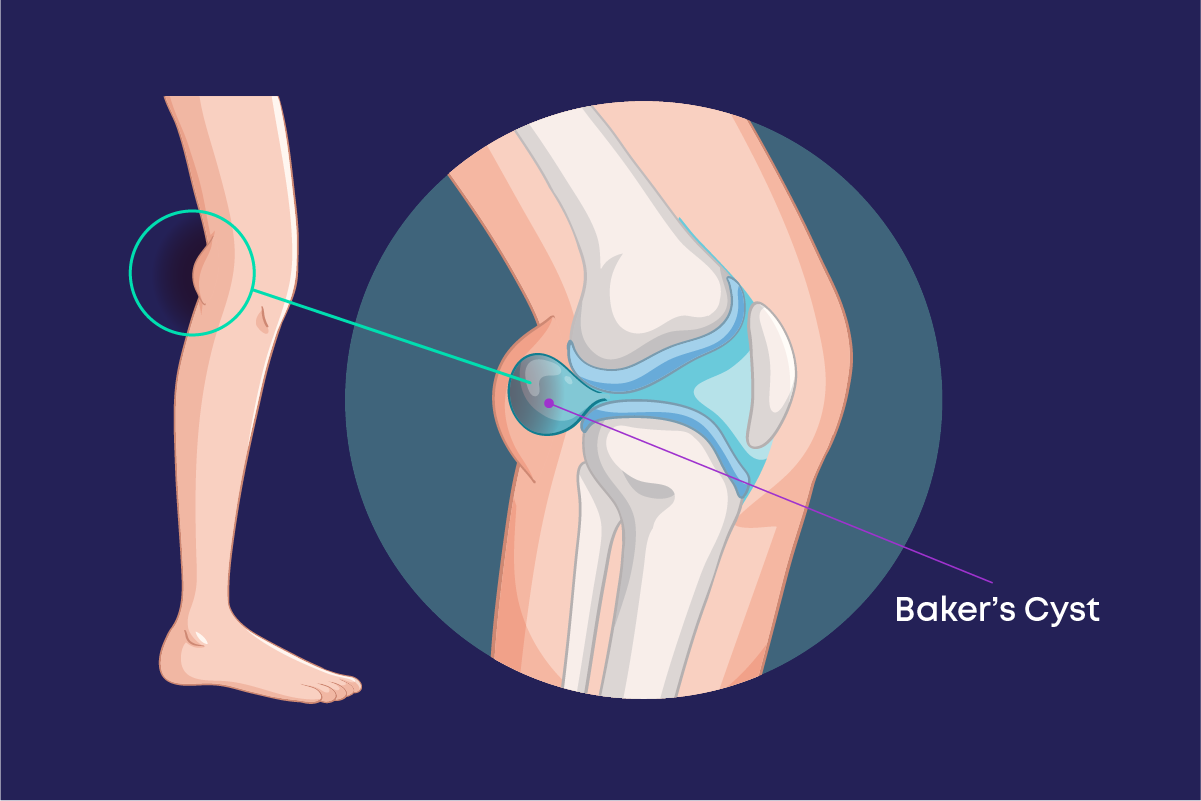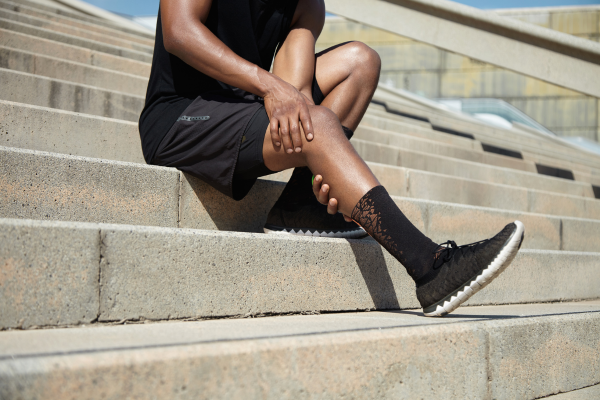Swelling behind the knee, discomfort, and a feeling of tightness when walking or bending the leg can all be signs of an underlying issue that needs to be addressed. A Baker’s cyst, also known as a popliteal cyst or a synovial cyst, usually develops in people aged 30 to 70, but can affect anyone at any age.
In this article, we’ll look at the common causes behind a Baker’s cyst, Baker’s cyst symptoms, and explore the most effective Baker’s cyst treatment.
What is a Baker’s Cyst?
A Baker’s cyst is a small fluid-filled bump that causes swelling behind the knee. It occurs when excess synovial fluid (the lubricating fluid in the knee joint) is pushed into a small sac at the back of the knee. This can happen due to something damaging the knee joint, or any tissue around it, causing extra fluid to drain out of the knee.
This fluid can only drain one way which is out of the back of your joint. This fluid buildup forms the sac which becomes a Baker’s cyst. Baker’s cysts are benign growths which means they aren’t tumours and are never a symptom of cancer. This means they also don’t cause cancer.

Causes of a Baker’s cyst
There are a few causes of a Baker’s cyst. The most common causes are a few different types of knee arthritis and injuries. Common forms of arthritis include:
- Osteoarthris.
- Rheumatoid arthritis.
- Gout.
Anything that damages your knee joint, such as a knee injury, can cause swelling and trigger a Baker’s cyst. These injuries include:
- Meniscus tears.
- Sprains.
- Dislocations.
- Bone fractures.
- Hyperextensions.
- Repetitive strain injuries.
- ACL, MCL, LCL, and PCL tears.
Anyone can develop a Baker’s cyst at any age. But it’s more common in:
- Athletes.
- People with arthritis.
- People aged 35 – 70 years old.
- People who regularly put lots of pressure on their knees.
Baker’s cyst symptoms
The most evident symptoms of a Baker’s cyst is swelling behind the knee that presents itself as a bump. Other symptoms include:
- Knee pain.
- Tightness or stiffness.
- Trouble bending or straightening the leg.
- Swelling in your knee or around it.
Some people don’t experience any symptoms, and might not know they have a Baker’s cyst until a healthcare provider notices it whilst diagnosing other issues.
Ruptured Baker’s cyst treatment
A ruptured Baker’s cyst can occur, causing fluid to leak into the calf. This will cause pain and tightness. A ruptured Baker’s cyst can also mimic symptoms of a blood clot, such as redness, swelling, or a sharp pain in the lower leg. A blood clot is an emergency, so if you think you have one, contact your healthcare provider straight away. Your healthcare provider will be able to determine between a ruptured Baker’s cyst and a blood clot.
What not to do when you have a Baker’s cyst
If you’re dealing with a Baker’s cyst, there are a few important things to stay away from to avoid making it worse. High impact activities such as running or jumping can agitate the cyst, so it’s best to stick to low impact activities such as swimming or cycling. Avoid prolonged kneeling or squatting as these movements put extra pressure on the knee and could cause a ruptured Baker’s cyst. Don’t ignore persistent pain or swelling, and resist the urge to mask symptoms with painkillers, as the Baker’s cyst could become worse without even realising.
Baker’s cyst treatment
A Baker’s cyst can be treated at home with ibuprofen, resting the knee, wearing a knee support, and holding an ice pack to your knee for 10-20 minutes to reduce swelling. The RICE method can also be used to treat it. If a Baker’s cyst stops you from using your knee or causes persistent pain and swelling behind the knee, further treatment will be required.
It’s sometimes possible to drain a Baker’s cyst, however, it may not be possible to drain long term cysts as the fluid inside of them becomes too thick. Surgically removing a Baker’s cyst isn’t easy due to them not having any lining, but surgery can be done and may be needed to repair the knee joint if it’s significantly damaged.
A type of keyhole surgery, known as an arthroscopy is usually used to remove a Baker’s cyst. This is where a surgeon will use an arthroscope to look inside the knee joint, using small surgical instruments along the arthroscope to repair any damage.
How osteopathy and physiotherapy can help treat a Baker’s cyst
While a Baker’s cyst often forms as a result of an underlying knee issue such as arthritis, osteopathy and physiotherapy can play a key role in relieving symptoms and addressing the root cause of the problem.
Osteopathy for relief
Osteopaths will aim to improve the function of the knee and ease strain through hands on treatment. When it comes to a Baker’s cyst, osteopaths may use gentle soft tissue techniques to reduce swelling behind the knee as well as tension, improve circulation and lymphatic drainage to help ease inflammation, and will address balances or restrictions in movement. Osteopaths will also offer guidance on stretches and strengthening exercises to support recovery and prevent recurrence.
Physiotherapy for long term management
Physiotherapists are focused on restoring movement and strengthening the structures around the affected joint. Physiotherapy treatment for a Baker’s cyst includes manual therapy to relieve pressure and improve joint alignment mobility and flexibility work to reduce stiffness, and tailored exercises to strengthen muscles supporting the knee.
How Carl Todd Clinics can help
At Carl Todd Clinics, our team of experienced osteopaths and physiotherapists can deliver a personalised treatment plan based on your symptoms and lifestyle. Whether your cyst is causing pain, swelling behind the knee, or is limiting your daily activities, we’re here to help you get back on your feet. Get in touch today to find out how we can help.





